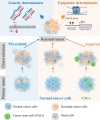A protracted war against cancer drug resistance
- PMID: 39342202
- PMCID: PMC11439304
- DOI: 10.1186/s12935-024-03510-2
A protracted war against cancer drug resistance
Abstract
Currently, even the most effective anti-cancer therapies are often limited by the development of drug resistance and tumor relapse, which is a major challenge facing current cancer research. A deep understanding of the molecular and biochemical bases of drug efficacy that can help predict the clinical drug resistance, coupled with the evolution of systematic genomic and proteomic technologies, have facilitated studies identifying and elucidating the underlying mechanisms. In this review, we focus on several important issues on cancer drug resistance and provide a framework for understanding the common ways by which cancers develop resistance to therapeutic agents. With the increasing arsenal of novel anticancer agents and techniques, there are now unprecedented opportunities to understand and overcome drug resistance. The proteolysis targeting chimera (PROTAC) technology, immunotherapy, nanomedicine, and real-time monitoring of drug response all provide effective approaches for combating drug resistance. In addition to the advancement of therapeutic technologies, the revolution of treatment concept is also of great importance. We can take advantage of the interplay between drug sensitive and resistant subclones for combating cancer. However, there remains a long way to go in the protracted war against cancer drug resistance.
Keywords: Cancer drug resistance; Cancer evolution; Cancer stem cells; Individualized medicine; Yin-Yang balance.
© 2024. The Author(s).
Conflict of interest statement
The authors declare no competing interests.
Figures






Similar articles
-
Circumventing cancer drug resistance in the era of personalized medicine.Cancer Discov. 2012 Mar;2(3):214-26. doi: 10.1158/2159-8290.CD-12-0012. Epub 2012 Feb 28. Cancer Discov. 2012. PMID: 22585993 Review.
-
The future of Cochrane Neonatal.Early Hum Dev. 2020 Nov;150:105191. doi: 10.1016/j.earlhumdev.2020.105191. Epub 2020 Sep 12. Early Hum Dev. 2020. PMID: 33036834
-
FLT3-PROTACs for combating AML resistance: Analytical overview on chimeric agents developed, challenges, and future perspectives.Eur J Med Chem. 2024 Nov 5;277:116717. doi: 10.1016/j.ejmech.2024.116717. Epub 2024 Aug 1. Eur J Med Chem. 2024. PMID: 39094274 Review.
-
Computer-aided drug repurposing for cancer therapy: Approaches and opportunities to challenge anticancer targets.Semin Cancer Biol. 2021 Jan;68:59-74. doi: 10.1016/j.semcancer.2019.09.023. Epub 2019 Sep 25. Semin Cancer Biol. 2021. PMID: 31562957 Review.
-
Overview of resistance to systemic therapy in patients with breast cancer.Adv Exp Med Biol. 2007;608:1-22. doi: 10.1007/978-0-387-74039-3_1. Adv Exp Med Biol. 2007. PMID: 17993229 Review.
Cited by
-
Overcoming resistance mechanisms in cancer immunotherapy-novel approaches and combinations.Naunyn Schmiedebergs Arch Pharmacol. 2025 Jun 11. doi: 10.1007/s00210-025-03963-w. Online ahead of print. Naunyn Schmiedebergs Arch Pharmacol. 2025. PMID: 40498093 Review.
-
Aripiprazole-loaded niosome/chitosan-gold nanoparticles for breast cancer chemo-photo therapy.BMC Biotechnol. 2024 Dec 24;24(1):108. doi: 10.1186/s12896-024-00939-1. BMC Biotechnol. 2024. PMID: 39719556 Free PMC article.
-
Discovery of a novel 4-pyridyl SLC-0111 analog targeting tumor-associated carbonic anhydrase isoform IX through tail-based design approach with potent anticancer activity.Front Chem. 2025 Apr 4;13:1571646. doi: 10.3389/fchem.2025.1571646. eCollection 2025. Front Chem. 2025. PMID: 40255643 Free PMC article.
-
TRPV1 inhibition sensitizes tumors to PD-1 blockade by reversing resistance to CTL-mediated killing.Sci Rep. 2025 Jul 1;15(1):20600. doi: 10.1038/s41598-025-07120-4. Sci Rep. 2025. PMID: 40594542 Free PMC article.
-
Metal Oxide Nanoparticles as Efficient Nanocarriers for Targeted Cancer Therapy: Addressing Chemotherapy-Induced Disabilities.Cancers (Basel). 2024 Dec 19;16(24):4234. doi: 10.3390/cancers16244234. Cancers (Basel). 2024. PMID: 39766133 Free PMC article. Review.
References
-
- Jiang K, Li X, Wang C, Hu X, Wang P, et al. Dual inhibition of CHK1/FLT3 enhances cytotoxicity and overcomes adaptive and acquired resistance in FLT3-ITD acute myeloid leukemia. Leukemia. 2023;37(3):539–49. - PubMed
Publication types
Grants and funding
LinkOut - more resources
Full Text Sources

